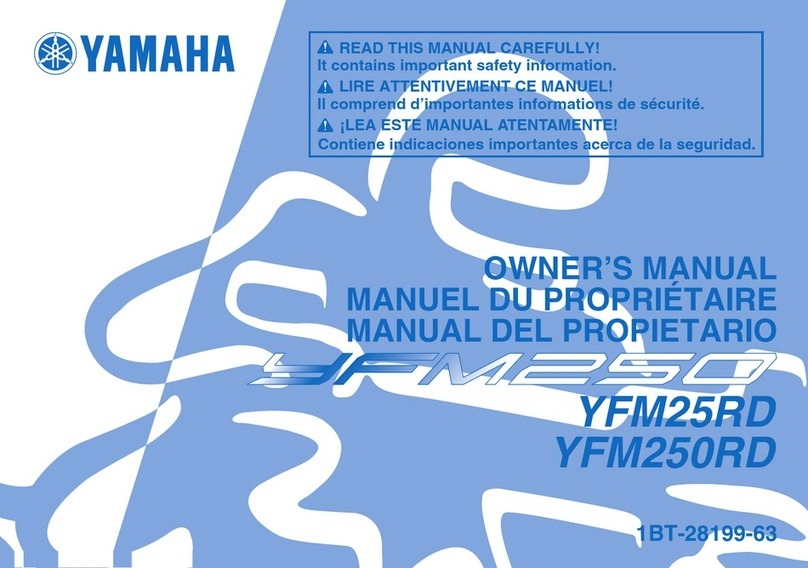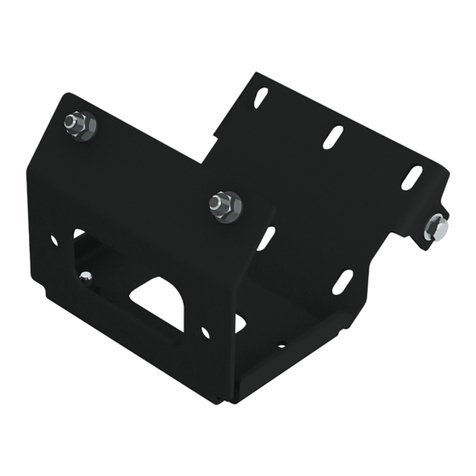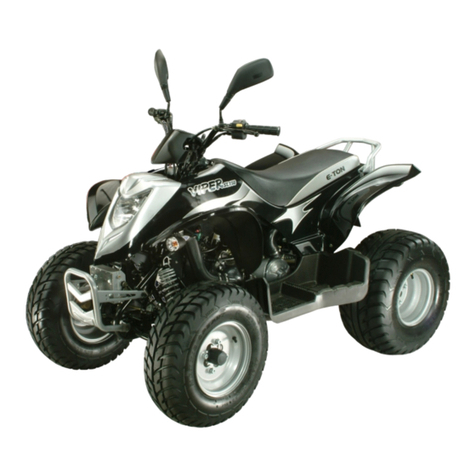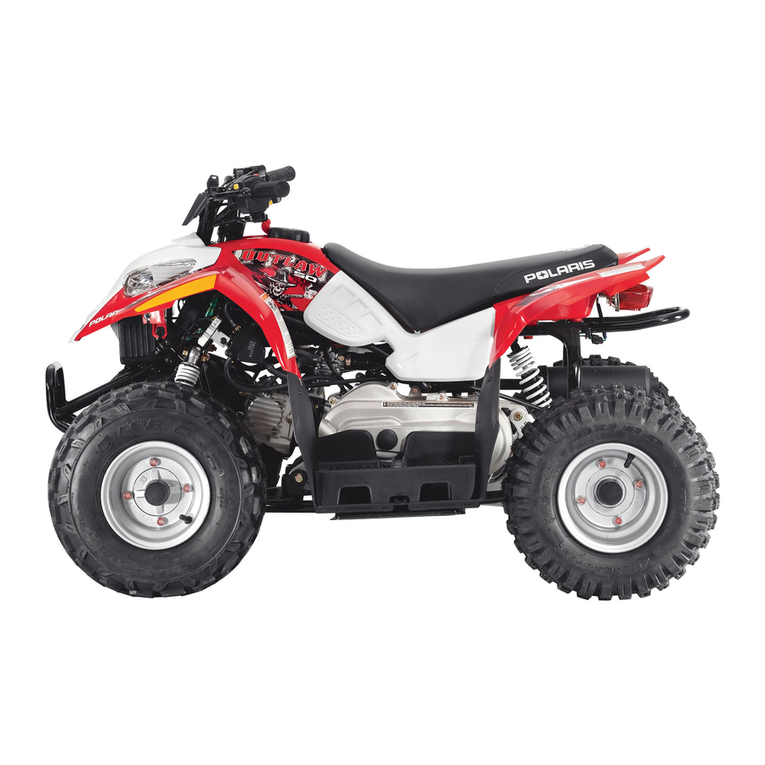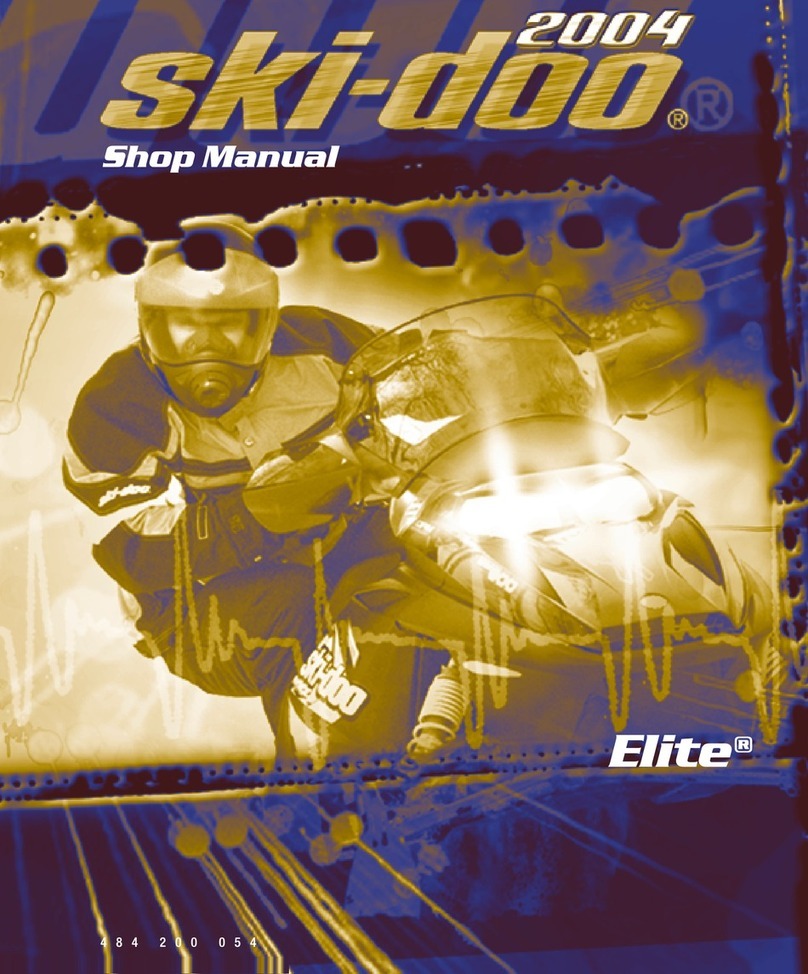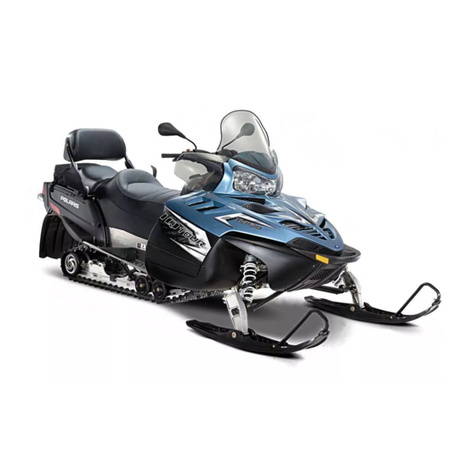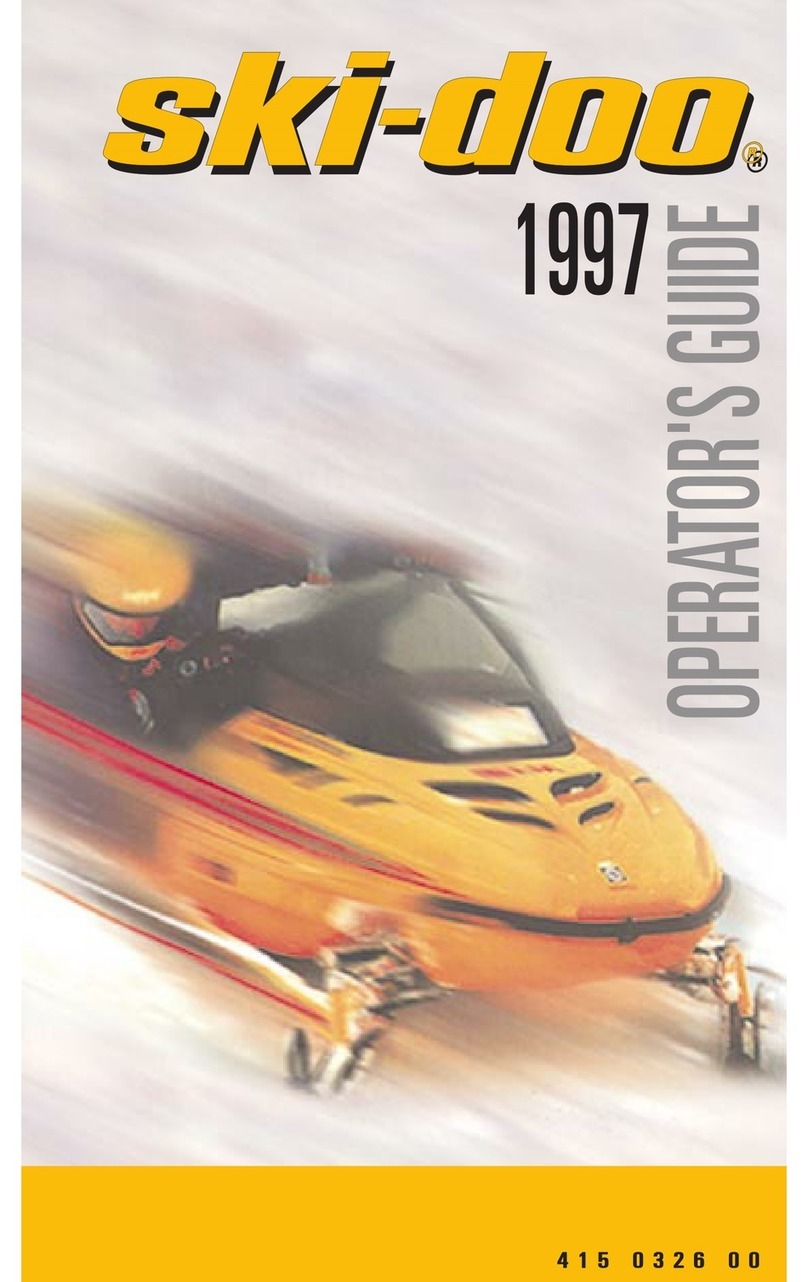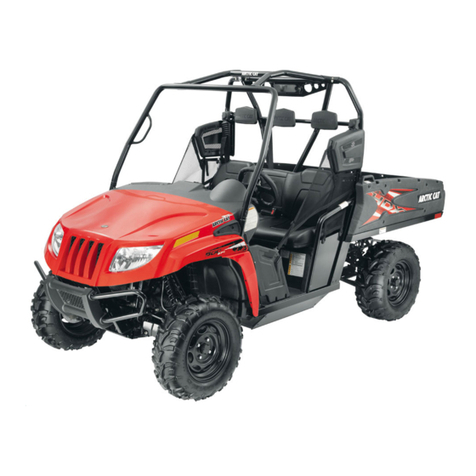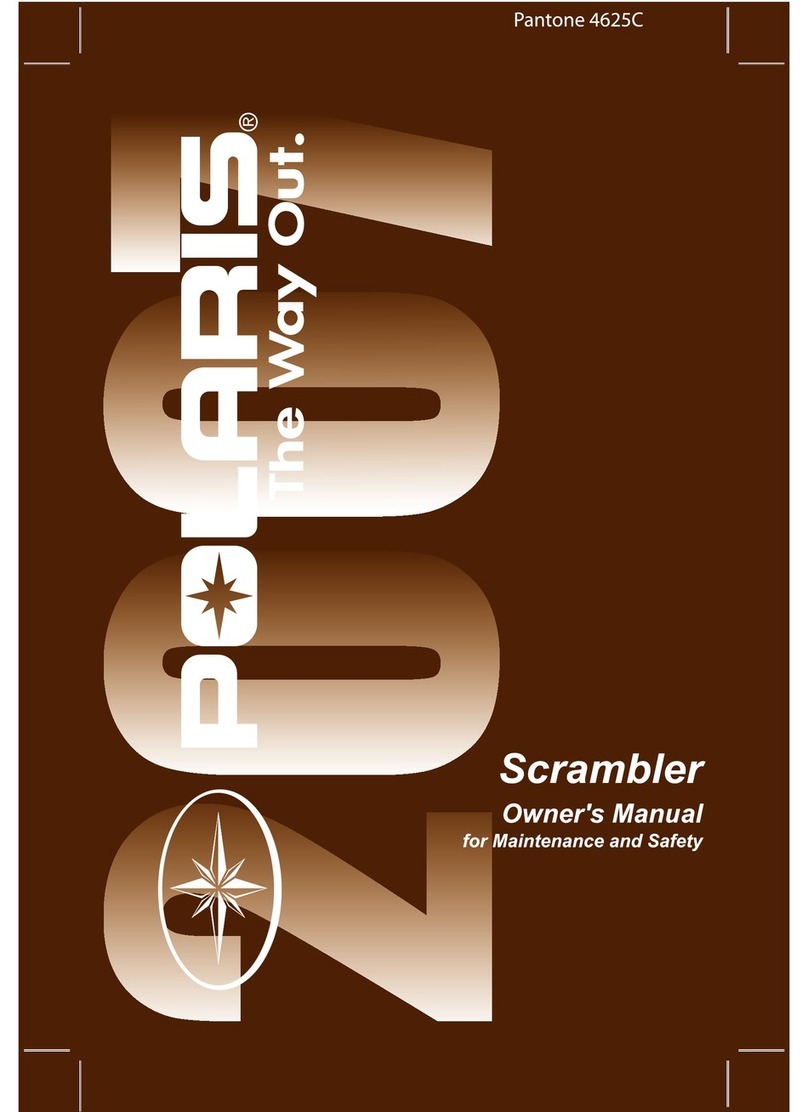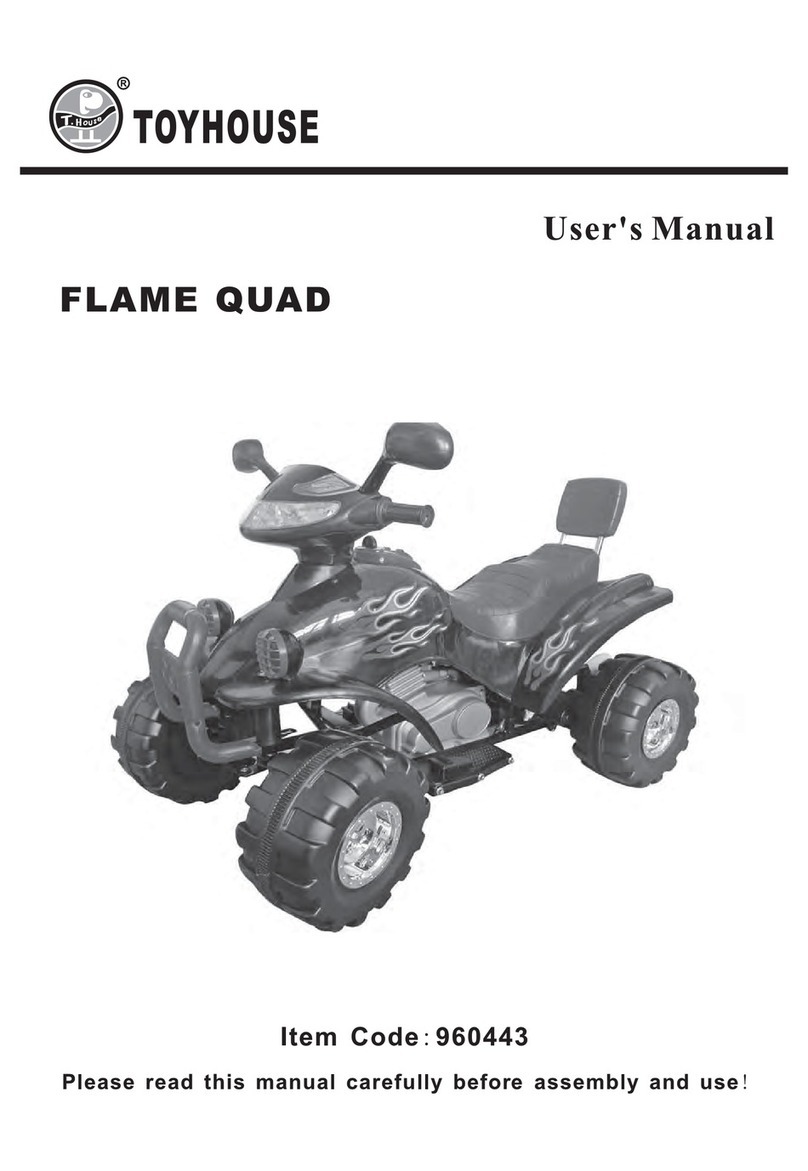TOMCAR TM2 User manual

OWNER’S MANUAL


1
WELCOME
We welcome you as the owner of a new TOMCAR®off-road vehicle. We trust that the years to come will prove you made a wise choice, and
your experience with your TOMCAR®will be truly special, full of many hours of service and enjoyment.
TOMCAR®Vehicle Variants
Two–Seater (TM2) Four–Seater (TM4) Two–Seater Pickup (TM5)
Your new TOMCAR® reects ne engineering honed over many years. This includes component selection, eld testing, customer
recommendations and vehicle manufacturing codes, which all lead to this ne utility and recreational vehicle.
Your safety is our prime concern, both while operating and servicing your TOMCAR® . We have achieved excellent safety records throughout
our history. In order to maintain this good record, we need your cooperation in following the instructions and recommendations outlined in this
Owner’s Manual.
This manual is a part of your TOMCAR®and should remain with the vehicle.
WARNING – CALIFORNIA PROPOSITION 65
WARNING: The engine exhaust from this product contains chemicals known to the state of
California to cause cancer, birth defects or other reproductive harm.


3
Vehicle Identication Numbers
Vehicle Identication Number
It is important that your vehicle identication number is kept in a safe place. Please record in the space provided below. Store a spare key in a
safe place. Should all keys be lost or stolen, please contact your TOMCAR®supplier for assistance.
For security purposes, the Vehicle Identication Number – VIN – also appears inside the center tunnel. (Not visible without disassembly.)
Frame VIN (under hood on middle frame bar): Ignition Key Number (stamped on key):
(A)________________________________________ ___________________________________________
Your Supplier Details:
__________________________________________
__________________________________________
__________________________________________
__________________________________________
Vehicle Delivery Date:
__________________________________________
Signature of Supplier (at delivery): Signature of Customer (at delivery):
__________________________________________ __________________________________________


5
Table of Contents
Table of Contents
SAFETY
8
Safe Operation Instructions
8
Safety Decals and Locations
17
Fuel Safety
21
FEATURES & CONTROLS
22
Component Locations
22
Towing Ball
26
Fuel Cap/Fuel Gauge
27
Dual Fuel Tank
28
Load Compensators (if so equipped)
29
Seat Belts
30
Console
31
Heater Operation (if so equipped)
33
Seat Adjustment
34
Steering Wheel Controls/Ignition Switch
35
Lights/Horn/Signal Control
36
Pedals
37
Gear Selector
38
Differential Lock Lever 39
Parking Brake
40
OPERATIONS
42
Emission Control System Warranty
42
Guidelines/Vehicle Break-In Period
45
Pre-Ride Inspection
46
Starting the Engine
49
Shutting Off the Engine 51
Braking
51
Driving Procedures
52
MAINTENANCE & LUBRICATION
61
Periodic Maintenance Chart
61
Lubrication & Fluid Recommendations
65
Engine Maintenance 69
Engine Oil Change
71
Transmission
74
Cooling System
76
Spark Plugs
80
Continuous Variable Transmission (CVT) System
81
Filter Systems
83
Throttle System
85
Brakes
86
Steering Wheel
89
4-Point Harness 90
Tires & Suspension
91
Shock Air Pressure Adjustment 9
4
Lights
95
Battery
97
Cleaning & Storing
99
SPECIFICATIONS
101


7
Model Legend
Model Legends
Throughout this Owner’s Manual when indication of a specic model is required, the model descriptor uses the “X” letter as a wild card (relating
to several models available).
The following list elaborates the various models and how they are reected within this manual:
TMX7X – Six models are derived from this descriptor:
1. TM27CL
2. TM47CL
3. TM57CL
4. TM27BL
5. TM47BL
6. TM57BL
(C – Gasoline Engine)
(B – Diesel Engine)
(L – High/Low Differential Lock Gearbox)

Safe Operation Instructions
8
SAFETY
Safe Operation Instructions
Reading and understanding the contents of this Owner’s Manual will protect you from injury and the vehicle from damage. Your knowledge of
safe operation of this vehicle will help you train others who may operate it. This is a powerful vehicle and, as such, all driving rules, licenses
and permits apply to all TOMCAR®models. Your TOMCAR®handles differently from other vehicles such as motorcycles, ATVs and cars.
Therefore, the driver must undergo training prior to use. If you ignore the warnings contained in this Owner’s Manual and on the vehicle, and
fail to take appropriate precautions, collisions or rollovers can happen quickly, even during routine driving maneuvers such as driving over
obstacles, turning, or hill driving, and may result in severe injury or death.
TOMCAR® is intended to be used off-road, where special driving skills and know-how are essential for safe operation.
Age Restrictions
Operation of this vehicle is limited to persons who are licensed and have been trained, including reading and understanding this Owner’s
Manual. No one under the age of 16 should be allowed to operate a TOMCAR® . The minimum age recommendation for passengers is 16 years
old. Young or inexperienced drivers may not be able to control the vehicle. Local regulations may also restrict the age of the driver.
Vehicle Awareness
This Owner’s Manual contains valuable information about all aspects of your vehicle which will enable you, as the driver of the vehicle, to be
responsible for your personal safety, the safety of others and the protection of the environment. It is important that you read, familiarize yourself
with and understand this manual.
The use of a TOMCAR® is subject to certain hazards that can only be protected against by the exercise of intelligence, care and common sense.
It is therefore essential to have a driver who is competent and careful, physically and mentally t, and thoroughly trained in the safe driving and
controlling of a TOMCAR®off-road.

SAFETY Safe Operation Instructions
9
It is important that you are familiar with and follow all laws and regulations concerning the operation of an off-road vehicle, such as the
TOMCAR®, which are in force in the area in which you use it. Follow the recommended maintenance program outlined in your Owner’s
Manual in order to ensure that all critical components on your vehicle are thoroughly inspected at the specied intervals.
When you see the safety alert DANGER, it is an indication that there is an immediate hazard that will result in severe personal injury or death.
When you see the safety alert WARNING, it is an indication that there is an immediate hazard that may result in serious personal injury or
death.
When you see the safety alert CAUTION, it is an indication that there is an immediate hazard that may result in minor personal injury or
damage to the vehicle.
CAUTION
When you see CAUTION, without the safety symbol it is an indication that there is a situation that may potentially cause property damage.

SAFETY
Safe Operation Instructions
10
• Fuel – Fuel is extremely ammable and is explosive under certain conditions. Always exercise extreme caution whenever handling fuel.
Service the vehicle only in a well-ventilated area.
• Battery – Explosive. Keep sparks and ames away from the vehicle. Ventilate when charging the battery or operating the vehicle in an
enclosed space.
• Always wear eye protection and gloves when handling the battery.
• Carbon Monoxide – Fuel engine exhaust contains poisonous carbon monoxide which can cause serious illness and death. Never run the
engine in an enclosed area, such as a building, without proper ventilation. To ventilate, connect a pipe extension to the exhaust pipe and
discharge the exhaust outdoors. Allow fresh air into the work area.
• Weather Hazards – Your TOMCAR® will not protect occupants from lightning, storm activity or ying objects. If operating in a storm,
leave the vehicle and seek appropriate shelter.
Please follow all instructions and procedures outlined in further detail within your Owner’s Manual. Failure to do so may result in serious injury
or death.
1. Please read this manual and all labels carefully and follow the operating procedures described.
2. Never allow anyone without a valid driver’s license and appropriate TOMCAR® training to operate this vehicle.
3. Drivers and passengers should wear their seat belts at all times.
4. When operating this vehicle, eye protection and helmets are recommended at all times.
5. Should you wish a guest to operate this vehicle, please ensure that they read this Owner’s Manual and all product labels.
6. In order to reduce the risk of rollover, be careful when encountering slopes and other obstacles, during turns and when braking.
7. Ensure that drugs or alcohol are never consumed before or while operating this vehicle.
8. Always travel at speeds proper for the terrain, visibility, operating conditions and your experience. Never operate at excessive speeds.
9. Never attempt jumps or other stunts.

SAFETY Safe Operation Instructions
11
10. Always follow the inspection and maintenance procedures at schedules described in this manual. Inspect your vehicle each time you use it
to make sure it is in safe operating condition.
11. Always use correct driving procedures when operating this vehicle. Keep both hands on the steering wheel and both feet on the oorboards
of the vehicle during operation.
12. When operating on unfamiliar terrain, be alert to changes in that terrain, travel slowly and use extra caution for maximum safety.
13. Use additional caution when driving on excessively loose, slippery or rough terrain.
14. Always practice turning at slow speeds before attempting to turn at faster speeds. Follow procedures for turning as described in this manual.
Never turn at excessive speeds.
15. Should this vehicle be involved in an accident, always have it thoroughly checked before continued use.
16. Practice operating the TOMCAR® on smaller hills before attempting larger hills. Never operate TOMCAR®on hills that are too steep for
the vehicle or your abilities.
17. Always check the terrain carefully before attempting to climb a hill and always follow the proper procedures for climbing hills as set out
in this manual. Never climb hills with excessively loose or slippery surfaces, never go over the top of hills at high speed. Never open the
throttle suddenly.
18. Check the terrain carefully before descending a hill and always follow the proper procedures outlined in this manual before traveling
downhill or braking on hills. Never travel downhill at excessive speeds, avoid going downhill at an angle which would cause the vehicle to
lean sharply to one side, and travel straight down the hill where possible.
19. Always follow the proper procedures outlined in this manual when operating over obstacles and never attempt to drive over large obstacles
such as rocks or fallen trees. Always check for obstacles before driving or operating the vehicle in an unfamiliar or new area.
20. On slippery surfaces such as ice or mud, travel slowly and be cautious in order to reduce the chances of skidding or sliding out of control.
At all times, be careful and aware of the dangers of skidding or sliding.
21. Never operate your vehicle in water deeper than that specied in this manual or in fast-owing water. Wet brakes may reduce stopping
ability, so test your brakes after leaving water and, if necessary, apply them lightly several times to allow the friction to dry them out.
22. When reversing, in order to ensure that it is safe to proceed, always make sure that there are no obstacles or people behind you, move
slowly when it is safe to do so, and avoid turning at sharp angles when in reverse.
23. Always use the correct type and size of tires specied in this manual, and maintain the correct tire pressure as specied in the maintenance
and specication sections of this manual.
24. Never modify this vehicle through improper installation or use of accessories.
25. When hauling cargo, ensure that the cargo is properly distributed and securely attached.

SAFETY
Safe Operation Instructions
12
26. Never exceed the stated load capacity for the vehicle.
27. When either hauling cargo or pulling a trailer, reduce speed and follow the instructions in this manual.
28. The 4-point safety harness or the 3-point inertia safety belt reduce the risk of severe injury in case of a sudden stop or collision. The
appropriate restraint should always be worn for the activity at hand.
29. Arms and legs should always be kept inside the cab frame while the vehicle is in motion.
30. The parking brake should always be engaged before leaving the vehicle.
31. The foot pedal brake should always be engaged before releasing the parking brake.
32. The engine should be turned off before refueling. Make sure the refueling area is well-ventilated and free from sources of sparks or ame.
33. In order to prevent any unauthorized use or accidental start-up, always remove the ignition key when the vehicle is not in use.
We recommend that the operator always check all safety components before using TOMCAR®in order to ensure that TOMCAR®is in excellent
operating condition at all times.
Equipment Modications
Do not make any modications to your TOMCAR®vehicle.
Operating your TOMCAR® with modications other than those specically designed for TOMCAR®may result in failure of critical machine
components, especially those which increase speed or power. TOMCAR® may become aerodynamically unstable at speeds higher than those
for which it is designed and loss of control may occur at higher speeds. Such modications may also create a safety hazard, which could lead to
bodily injury.
The warranty on your TOMCAR® is terminated if any modications have been made to the vehicle or any equipment has been added to the
vehicle that increases its speed or power.

SAFETY Safe Operation Instructions
13
WARNING
Potential hazard What can happen How to avoid hazard
Stalling, rolling backward while climbing a
hill
Vehicle overturn Maintain a steady speed when climbing a hill.
IF YOU LOSE ALL FORWARD SPEED:
• Apply the brakes.
• Lock the parking brake when fully
stopped.
IF YOU BEGIN ROLLING BACKWARD:
• Never apply engine power.
• Apply the brake gradually.
• When fully stopped, lock parking brake.
• In the event of an accident, have a
qualied service supplier check the
complete vehicle for possible damage.

SAFETY
Safe Operation Instructions
14
WARNING
Potential hazard What can happen How to avoid hazard
Operating this vehicle without proper
instruction
Loss of control, accident The risk of an accident is greatly increased
if the operator does not know how to operate
the vehicle properly in different situations and
on different types of terrain.
All operators must read and understand
the Owner’s Manual and all warning and
instruction labels before operating the
vehicle.
Operating this vehicle after consuming
alcohol or drugs
Could seriously affect your judgment
Could cause you to react more slowly
Could affect your balance and perception
Could result in an accident
Driving a TOMCAR®requires your full
attention. DO NOT drink alcohol or use drugs
or medications before or while driving. They
will reduce your alertness and slow your
reaction time.
In most states and provinces, it is prohibited
by law to drive while intoxicated or under the
inuence of drugs.
Operating this vehicle on public streets, roads
or highways
Collision with another vehicle Avoid operating this vehicle on public streets,
roads or highways
Operating this vehicle at excessive speeds Loss of control, accident Always travel at a speed proper for the
terrain, visibility and operating conditions,
and your experience.
Attempting jumps and other stunts Loss of control, accident and/or vehicle
overturn
Never attempt jumps and other stunts. Avoid
exhibition driving.
Operating on frozen bodies of water Severe injury or death can result if the vehicle
and/or the operator fall through the ice
Never operate the TOMCAR®on a frozen
body of water.

SAFETY Safe Operation Instructions
15
WARNING
Potential hazard What can happen How to avoid hazard
Failure to inspect the vehicle before operating
Failure to properly maintain the vehicle
Accident, equipment damage Always inspect your TOMCAR®before
each use to make sure it is in safe operating
condition.
Always follow the inspection and
maintenance procedures and schedules
described in this Owner’s Manual.
Failure to use extra caution when operating
this vehicle on unfamiliar terrain
Loss of control, vehicle overturn Travel slowly and use extra caution when
operating on unfamiliar terrain.
Always be alert to changing terrain
conditions when operating the vehicle. You
may come upon hidden rocks, bumps or
holes suddenly, without enough time to react.
Failure to follow the minimum age
recommendations for this vehicle
Serious injury or death (to the child or
others)
Only persons with a valid driver’s license
should operate a TOMCAR®.
Even though a child may be within the
age group for which some vehicles are
recommended, he or she may not have the
skills, abilities or judgment needed to operate
the vehicle safely and may be involved in a
serious accident.
Operating this vehicle with improper tires, or
with improper or uneven tire pressure
Loss of control, accident and/or overturn Always use the size and type of tires specied
in the Owner’s Manual for this vehicle. See
pgs 91-93.
Always maintain proper tire pressure as
described in the Owner’s Manual. See
specications at rear of manual.

SAFETY
Safe Operation Instructions
16
SAFETY
Safe Operation Instructions
16
NOTE:
• Use only TOMCAR®-approved accessories and familiarize yourself with their function and effect on the vehicle. The addition of certain
accessories, including (but not limited to) extra wheels, extra fuel tank, etc. may change the handling characteristics of the vehicle.
Leaving the keys in the ignition can lead to unauthorized use of the vehicle resulting in serious injury or death. Always remove the ignition key
when the vehicle is not in use.
After any overturn or accident, have qualied service personnel inspect the entire vehicle for possible damage, including (but not limited to)
brakes, throttle and steering systems.
CAUTION:
Always keep combustible materials away from the exhaust system. Exposure to the hot components could result in a re.

SAFETY Safe Operation Instructions
17
SAFETY Safety Decals and Locations
17
Safety Decals and Locations
Warning decals have been placed on the TOMCAR®for your protection. Read and follow the instructions of the decals on the TOMCAR®
carefully. If any of the decals depicted in this manual differ from the decals on your TOMCAR®, always read and follow the instructions of the
decals on the TOMCAR®.
If any decal becomes illegible or comes off, contact your TOMCAR®supplier to obtain a replacement. Replacement safety decals are provided
by TOMCAR® at no charge. The part number is printed on the decal.
This general purpose off-road utility vehicle does not meet federal motor vehicle safety standards for on-road vehicles.
Safety Decals and Locations
SAFETY

SAFETY
Safety Decals and Locations
18
1
This cab frame is not designed or intended to provide rollover protection.
VEHICLE ROLLOVER could cause severe injury or death.
ALWAYS WEAR YOUR SEAT BELT AND HELMET for maximum protection.
WARNING
Location 1 (Rear Cross Tube)
This manual suits for next models
3
Table of contents

